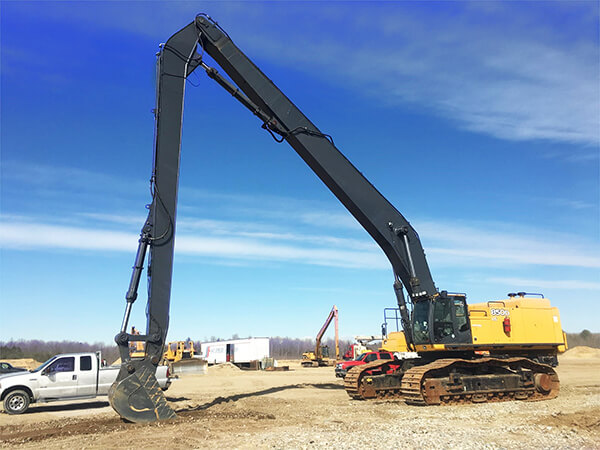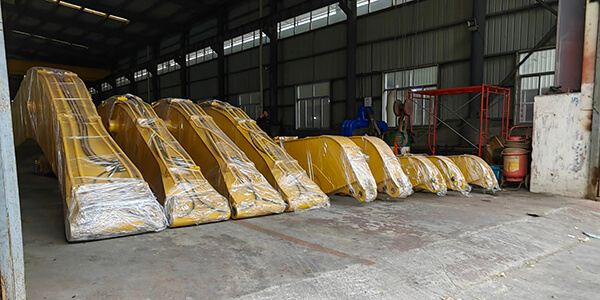Construction and excavation projects often require reaching new heights or digging deeper depths. Thanks to the marvels of modern engineering, the digger long front boom has revolutionized the industry. In this article, we will explore the design, applications, advantages, limitations, and the incredible ways in which long reach booms enhance the capabilities of standard excavators.

- The Anatomy of a Long Reach Boom
A long front boom is a unique attachment that extends the reach of an excavator. It typically consists of an extended arm and boom, replacing the standard configuration. Meticulously engineered and constructed using high-quality materials, digger long front boom are designed to withstand demanding construction site conditions.
The extended arm allows the excavator to reach further distances, while the boom provides stability and support. The arm is longer and lighter than the standard arm, enabling increased maneuverability. The boom connects the arm to the excavator’s main body, ensuring stability and transferring hydraulic power to operate the attachment effectively.
- Unleashing the Reach
The primary purpose of an excavator long front boom is to extend the machine’s reach beyond its standard capabilities. By attaching a long reach boom, an excavator gains access to areas that were previously out of reach. Deep trenches, high walls, and structures requiring demolition become more accessible. Long reach booms offer unparalleled flexibility, allowing construction and excavation projects to be completed with greater ease.
In dredging projects, excavators with long reach booms effectively remove sediment and debris from bodies of water, deepening channels or creating new waterways. Deep foundation excavations benefit from the extended reach, enabling excavation at greater depths to stabilize structures. Slope finishing, river or canal maintenance, and environmentally sensitive projects also benefit from long reach booms, as they allow work to be completed without disturbing the surrounding landscape.

- Engineering Marvels
Creating a reliable and efficient long reach boom requires precise engineering and meticulous attention to detail. Engineers calculate stress points, weight distribution, and hydraulic systems to ensure optimal performance. High-tensile steel and other durable materials withstand the extreme forces and pressures encountered during operation. These engineering marvels demonstrate the synergy between cutting-edge technology and the demands of modern construction.
Hydraulic systems play a crucial role in digger long front boom operation. Hydraulic cylinders, pumps, and valves work together to extend and retract the arm, control the boom’s movement, and provide power for digging and lifting. Advanced hydraulic systems allow for precise control, smooth operation, and enhanced operator productivity and safety.
- Advantages and Limitations
Long reach booms offer numerous advantages, but it’s important to consider their limitations. The extended reach comes at the expense of reduced lifting capacity and stability. The excavator’s center of gravity shifts when using a long reach boom, making it less suitable for heavy lifting tasks. Operators must be mindful of load capacities and operating parameters to maintain safety and performance.
Despite the limitations, long reach booms provide exceptional benefits. They enable access to otherwise challenging areas, saving time and labor costs. The increased reach enhances project efficiency, allowing work to be completed without requiring additional equipment or manual labor. Long reach booms also minimize site disruption, especially in sensitive environments, by reducing the need for excessive earthmoving or land alteration.
- Future Developments
As technology advances, the capabilities of long reach booms continue to expand. Engineers and manufacturers are constantly exploring ways to improve reach and performance while addressing the limitations of current designs. One area of development focuses on enhancing the lifting capacity of long reach booms without compromising stability. This involves innovations in structural design, material selection, and hydraulic systems to optimize the balance between reach and lifting capabilities.
Additionally, advancements in hydraulic control systems aim to provide even greater precision and responsiveness. This allows operators to fine-tune the movements of the long reach boom, enabling more delicate operations in restricted spaces. Improved control systems can also enhance safety features, such as automatic overload protection and real-time monitoring of hydraulic pressure and stability.

Furthermore, researchers are exploring the integration of sensor technologies and automation into long reach booms. By incorporating cameras, LiDAR, and other sensors, excavators equipped with long reach booms can provide operators with real-time feedback on the surrounding environment, enhancing situational awareness and improving accuracy during operations. Automation features can assist in repetitive tasks and streamline operations, improving overall efficiency.
Another area of development focuses on environmental sustainability. Manufacturers are exploring ways to reduce the carbon footprint of long reach booms by improving energy efficiency and incorporating eco-friendly materials. This includes the use of hybrid or electric power systems and the integration of regenerative braking systems to capture and reuse energy during operation.
In conclusion, digger long front boom have revolutionized the construction and excavation industry by extending the reach and capabilities of standard excavators. Through meticulous engineering and advanced hydraulic systems, these attachments provide access to challenging areas and enhance project efficiency. While they have certain limitations, the advantages of digger long front boom, such as increased flexibility and reduced site disruption, make them invaluable tools in a wide range of applications. As technology continues to advance, we can expect further improvements in reach, lifting capacity, precision, automation, and sustainability, opening up new possibilities for construction and excavation projects in the future.